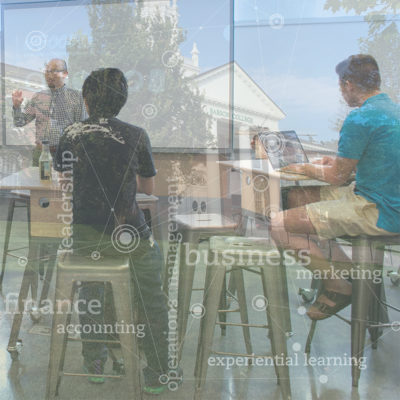
Photo: Justin Knight
Babson College was an academic novelty in its early years, even for a business school. The school was practical, forward-thinking, and comprehensive. Students lived like executives, arriving to class in professional attire, dictating tasks to assistants, and punching in and out during traditional business hours.
Today, students arrive at Babson from more than 80 countries and work diligently, no punching out required, to learn entrepreneurship and other business essentials, such as finance, accounting, marketing, and operations management. Foundations of Management and Entrepreneurship is a first-year undergraduate course in which students create, build, and start a business. Some 127 entrepreneurship courses are offered, taught by 53 faculty members, most of whom have considerable entrepreneurial experience. U.S. News & World Report has ranked the F.W. Olin Graduate School of Business at Babson College the No. 1 program for entrepreneurship for the past 26 years.
“We have the largest separate department of entrepreneurship in the world, and yet we’re a small school,” says Candida Brush, The Franklin W. Olin Distinguished Chair of Entrepreneurship and Vice Provost of Global Entrepreneurial Leadership.
This evolution, which has progressed from the college’s buttoned-up beginnings to its modern-day role as an entrepreneurship powerhouse, has been years in the making, with enlightened Babson leaders seizing opportunities to push beyond boundaries at key moments. Over the years, these trailblazers have backed up big-picture thinking with programs and classes emphasizing experiential learning designed to give students a decided advantage in their career path, building on and modernizing Roger Babson’s original vision.
This vision didn’t always take precedence. In the years following the Great Depression and World War II, company loyalty was in; an entrepreneurial mindset was out.
“The 1940s, 1950s, 1960s, and 1970s were the eras of big business. The attitude of the time was, do good for your company, and the company will do good for you,” says William Bygrave, entrepreneurship professor emeritus at Babson College.
Bygrave credits two former Babson professors for boosting the College’s reputation in entrepreneurial education: Karl Vesper, who started the Babson College Entrepreneurship Research Conference (BCERC), and the late Jeffry Timmons, who created the Price-Babson Symposium for Entrepreneurship Educators (SEE).
President Ralph “Bud” Sorenson arrived in 1974. He took control—wooed from Harvard Business School by the spirit and air of friendliness at Babson, he says—in a difficult era for entrepreneurship, but one rife with opportunity.
During his tenure, he pushed the school to define itself as a leader in entrepreneurship. Under Sorenson, Babson became a pioneer in the field of entrepreneurship, making the school the first to establish entrepreneurship as a discrete academic discipline.
Carving a Niche
Sorenson reflects on his time at Babson from his airy carriage house off of Brattle Street in Cambridge, Massachusetts. He recalls his seven-year presidency with a twinkle in his eye and a modest grin.
“My thought was to identify an underserved niche that had potential and would give Babson a distinctive competitive advantage,” he says. “A lot of people thought, ‘You cannot teach entrepreneurship. You’re either born with the entrepreneurial gene, or you’re not.’”
Sorenson didn’t buy the idea of entrepreneurship as the birthright of those coming from a family business. He analyzed what graduates had done after Babson and noticed that a significant number had become presidents and CEOs of companies; many were self-employed. With the encouragement of late professor Jack Hornaday P’76, H’99 who already was teaching entrepreneurship, he knew he’d found Babson’s niche.

Art: Cathy Cahill
“It built on a historical tradition already in place at Babson, there were no other business schools with such a specialty, and such a focus had a good chance of winning the support of most of the management faculty, regardless of their functional area,” he says.
He set in place several seismic shifts. More courses and outlets for entrepreneurship were added at the undergraduate and graduate levels, including the Center for Entrepreneurship Studies in 1978 and a newly established undergraduate entrepreneurship major in 1979. The Center for Entrepreneurship created BCERC in 1981, one of the first of its kind. SEE began a degree outreach program to help faculty at other business schools teach entrepreneurship, establishing Babson as a leader in the field.
“There are now 8,000 graduates of that program and people who are teaching entrepreneurship education around the world. That’s a large reason why we’re still ranked No. 1,” Sorenson says.
He also was shrewd enough to capitalize upon the power of celebrity.
In 1977, Sorenson devised a way to draw attention to the school’s new mission: The Academy of Distinguished Entrepreneurs, an annual induction ceremony drawing the biggest names in business. While many business schools maintained hall of fame programs, this was the first to pay homage to outstanding innovative entrepreneurs who created wealth and jobs.

In Foundations of Management and Entrepreneurship, students develop and launch a real business.
Photo: Tony Rinaldo
The first ceremony honored Motown’s Berry Gordy Jr.; McDonald’s founder Ray Kroc; Soichiro Honda, founder of Honda Motor Co.; Ken Olsen, co-founder of Digital Equipment Corp.; and Royal Little, founder of Textron. Since then, the academy has honored more than 100 people.
An Entrepreneurial Mindset
Entrepreneurial thinking—not merely entrepreneurship as a discipline—is the fundamental part of Babson’s campus culture.
This is largely due to President Len Schlesinger, who arrived on campus in 2008 eager to further differentiate the College and redefine entrepreneurship for a new era. At Babson, entrepreneurship had become a way of thinking adaptively and creatively, for economic and social good.
Babson harbored the philosophy but lacked the language to communicate it concisely. Schlesinger was three months into his tenure when Danna Greenberg, the Walter H. Carpenter Professor of Organizational Behavior, uttered a captivating phrase during a faculty listening session: “entrepreneurial thought and action.”
Schlesinger seized upon it, and Entrepreneurial Thought & Action became Babson’s trademark calling card.
The seven directives of ET&A are: the strong desire to create; beginning with what you have, rather than what you think you need; paying only what you can afford to lose; enrolling others in your journey, as ET&A is about collaboration rather than competition; taking small action—with no excuses; building on what you learn; and reflecting and being honest with oneself.
The methodology can be used anywhere, from a big corporation, to a nonprofit, to a family business. It urges entrepreneurs to pivot between traditional prediction logic, relying on analysis, to creation logic, or feeling emboldened to take action despite unknowns.
Naming this methodology solidified Babson’s mission, further distinguishing it in a crowded market as more schools began to teach entrepreneurship.
Schlesinger vowed to make Babson the only school that applied that entrepreneurial mindset to five key areas: large organizations, social innovation, family businesses, scale-ups, and startups. Trademarking the phrase Entrepreneurship of All Kinds, he emphasized that anyone can become an entrepreneur, and that entrepreneurial thinking could be taught.
“The notion that, given uncertainty in the world, entrepreneurship is the framework for new leaders was a way to essentially argue that what we do in entrepreneurship applies everywhere as it evolves,” Schlesinger says.
The directive is baked into Babson’s vision statement: to expand the notion of entrepreneurship to embrace and celebrate entrepreneurs of all kinds.
Taking the Initiative
Today, ET&A is the underpinning of every Babson initiative. The Babson Academy for the Advancement of Global Entrepreneurial Learning offers programs that develop faculty to teach entrepreneurially, as well as entrepreneurship boot camps for undergraduate and graduate students at 37 other institutions. Both are instrumental in growing the Babson method exponentially. The Global Entrepreneurship Monitor research consortium, part of The Arthur M. Blank Center for Entrepreneurship, involves more than 500 researchers worldwide and is the most developed research program on entrepreneurship in the world. The Center for Women’s Entrepreneurial Leadership is host to the Diana Project, an annual conference providing more than 100 scholars with a platform to share global research dedicated to women entrepreneurs and their ventures.
At the Blank Center, hundreds of entrepreneurs and businesses use the John E. and Alice L. Butler Launch Pad as an incubator to jump-start their businesses, with advisory support from Babson faculty. Other students test their ideas at the annual Rocket Pitch, a fast-paced showcase that also draws students from neighboring Olin and Wellesley colleges, where students pitch business ideas to potential investors. The B.E.T.A. (Babson Entrepreneurial Thought & Action) Challenge is a competition that rewards the top undergraduate, graduate, and alumni who put Babson’s ET&A methodology into action with a $20,000 grand prize.
“Today, entrepreneurship classes are everywhere,” says Brush. “Entrepreneurship books? There are thousands of them. Here at Babson, we knit together what goes on in and out of the classroom to create a culture that’s hard to replicate, where we connect student experiences through immersive lab experiences to the learning inside the classroom.”
This tradition of applied learning will prove critical in the years ahead, says Sorenson.
“There is a famous saying: ‘One thorn of experience is worth a whole thicket of advice.’ And that goes back to where I think Babson has a bit of a head start,” Sorenson says. “The whole idea of formal education beginning in kindergarten, ending with a degree, either high school or college, and that’s the end of the approach? That’s so yesteryear. We have to become lifelong learners, given how fast the world is changing.”
Kara Baskin is a freelance writer in Arlington, Massachusetts.
